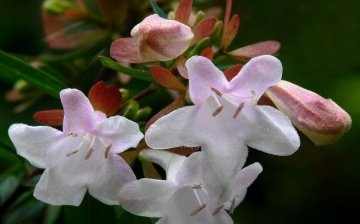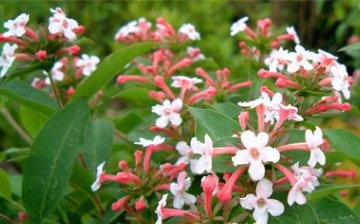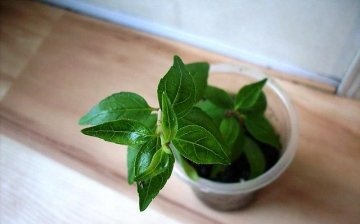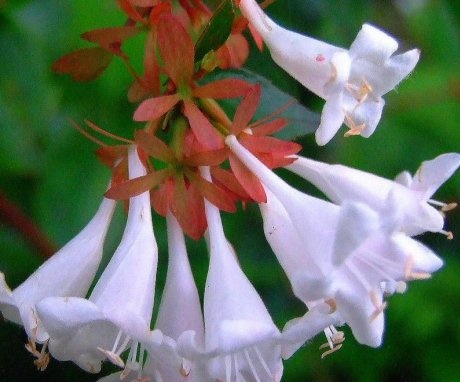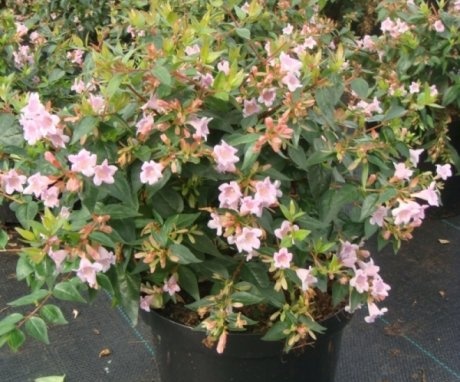Abelia large-flowered: rules of care and reproduction
Abelia is a delightful plant that can be grown both in the garden and in the room. The shrub plant stretches up to several meters in height and is used for group compositions and hedges.
Content:
- Description of abelia grandiflorum
- Variety of species
- Plant care in the garden and at home
- Reproduction and possible pests of large-flowered abelia
Description of abelia grandiflorum
Abelia flower belongs family Honeysuckle... In total, about 30 species of abelia are known, among which there are both shrub representatives and tree-like ones.
Abelia came to us from China and Japan. The plant was named after Clark Abel, an English doctor and researcher who worked in China until the 19th century.
The peculiarity of abelia is the leaves on a short petiole, bell-shaped flowers emitting a pleasant aroma. Abelia is suitable for growing in large rooms or greenhouses, in open areas the plant can grow up to 4 meters in height.
Plant characteristic:
- Abelia is an evergreen plant, only some species shed their leaves for the winter. The arrangement of the leaves is opposite, in shape they are entire, serrate or crenate.
- Flowers are not always collected in inflorescences (bunches or panicles), sometimes they are located one or two on apical or axillary peduncles. Abelia's fruit is one-seeded, leathery.
- The flowering period begins in April and ends in September, but this does not apply to all species, some may bloom a little later. Abelia is actively developing, in a year it can grow from a young plant into a full-fledged shrub.
- The flowers of the plant are tubular: bell-shaped or funnel-shaped. They are small in diameter, the maximum diameter reaches 5 cm. The flowers have 5 petals, most often they are white or pink, less often purple or red.
It is necessary to select a species for growing in the garden depending on the climatic conditions of the region. Most of the representatives are thermophilic, but there are also species that tolerate frosty winters.
Abelia does not lose its decorative properties even after the flowering period.
When the flowers at the ends of the branches fall away, purple sepals will remain in their place, which also look unusual and attractive. In the garden, abelia is grown either singly or in groups, landscape designers use shrubs to separate the recreation area from the site, to decorate the gazebo or verandas. Abelia is not afraid of pruning, so a hedge can be constructed from it.
Abelia is a delicate plant with small bell-shaped flowers. The plant is self-sufficient and does not always need other colors to create a complete composition.
Variety of species
Several types of abelia are cultivated in our area, among them:
- Large-flowered
- Chinese
- Profusely blooming
- Schumann
- Three-flowered
The most common type of abelia is a hybrid species - large-flowered abelia.
- It is a semi-evergreen shrub, small in size.
- This species is distinguished by long shoots that grow up to 1 meter, small but oblong leaves, light delicate flowers, collected in cluster inflorescences.
- Abelia large-flowered was formed by crossing Chinese Abelia and one-flowered.
- It became popular not only because of its attractive appearance and lush flowering, but also due to the duration of this period.
- When grown in a room, large-flowered abelia produces long and thin shoots, a slightly pinkish hue, which will disappear with age.
- Leaves are dark green, shiny, pointed.
- The flowers are large, consist of 5 petals, are collected in a cluster inflorescence, white color, emit a delicate aroma.
Abelia large-flowered has a variety with its own differences. The flowers are purple-red, and the leaves with a golden tint.
Chinese abelia:
- It is semi-evergreen and grows up to 2 meters in height.
- A distinctive feature is a large number of thin drooping shoots.
- The leaves are dark green, pointed at the ends.
- The flowers are white, bell-shaped in shape, have red spots.
- The flowering period is also long.
Another popular species is Abelia abelia:
- The shoots of the plant are pubescent, have a red tint.
- The leaves are wide, glossy. But most of all, it is the flowers of the plant that attract attention, they are pink, no more than 4 cm in size, funnel-shaped in shape, emit a delicate delicate aroma.
- The flowering period is long, up to 4 months.
Two more species are less common, but no less attractive. Abelia shumana is a deciduous shrub representative, it has dark green oval leaves and lilac flowers. The flowering period lasts from June to September.
Abelia three-flowered:
- Large shrub, sometimes referred to as undersized trees.
- The flowering period lasts from June to September, the plant is covered with lilac flowers.
Plant care in the garden and at home
Abelia can be grown both in the garden and indoors. Caring for them is slightly different, but has common features. The main condition that will ensure active growth and development of the flower is correct lighting. The shrub is located in a well-lit place, it should not be exposed to direct sunlight, the light should be diffused. The plant will develop in direct sunlight, but most likely it will not bloom, since this is detrimental to the petals.
The plant is located on the southeast or south side. The room should have light curtains on the windows. The ambient temperature is also important for the plant. Abelia does not like heat, so 22 degrees are enough for her in summer, and 10-15 degrees in winter. In a greenhouse or room, the temperature starts to drop in October.
The plant is difficult to tolerate winds and drafts, this should be taken into account when choosing a permanent place. Even the summer wind has a detrimental effect.
Abelia loves moisture, this applies not only to abundant watering, but also to air humidity.
If possible, the leaves should be sprayed, especially during dry periods. The pot is selected large, the substrate is mixed.
You can prepare the soil yourself using the following ingredients: 1 part sand plus 2 parts humus plus 2 parts peat soil plus 2 parts turf soil.
Plant care secrets:
- Abundant watering is provided in spring and summer, during the rest of the year watering is reduced to moderate. Even in winter, the soil should not be allowed to dry out.
- The shrub is good for fertilization. Top dressing is applied during the period of active growth, you can use a universal fertilizer for indoor plants, you can alternate mineral and organic fertilizing. They are brought in 2 times a month, in autumn and winter this is not required.
- Since the plant is actively growing, at a young age it is transplanted annually. Do not forget about pruning, it is done when the last flower fades. Pruning is needed for the splendor of the shoots.
- Good drainage is provided for an outdoor plant, the soil should be rich. It is also important to protect the plant from direct sunlight and water in a timely manner.
- After flowering, pruning is done.
Reproduction and possible pests of large-flowered abelia
Reproduction of abelia is carried out in several ways:
- Seeds.
- Green cuttings.
- Lignified cuttings.
It is important to undo that even stimulants do not help increase rooting, which is extremely low. The shrub has developed root growth, thickened clumps.
Most often, root shoots are planted for reproduction of Abelia. Each sprout can form a new shrub. A large number of them are formed over the season, so there is a chance that some of them will take root.
The shoot is separated from the bush at the end of summer, after that it lands in a permanent place. The air temperature should not be below 20 degrees. You can try to propagate cuttings, for this they are placed in a light substrate, for example, perlite, peat or sand and kept at a temperature of 20-25 degrees until rooting. In the same season, with a successful scenario, you can get a small bush that will bloom.
Abelia must be monitored carefully, especially outdoors, as it is susceptible to pests and parasites.
The most common bush destroyers are:
- Aphid
- Thrips
- Shield
- Spider mite
- Mealybug.
Parasites will not make themselves felt if you follow all the rules for caring for the plant. You can get rid of parasites by changing the rules of care and treating them with appropriate insecticidal preparations.
It is not always easy to propagate a plant, but it will thank you with flowering already this year. Depending on the type of abelia, you can get a shrub or woody plant. The plant will bring a minimum of hassle and maximum pleasure.
More information can be found in the video.



